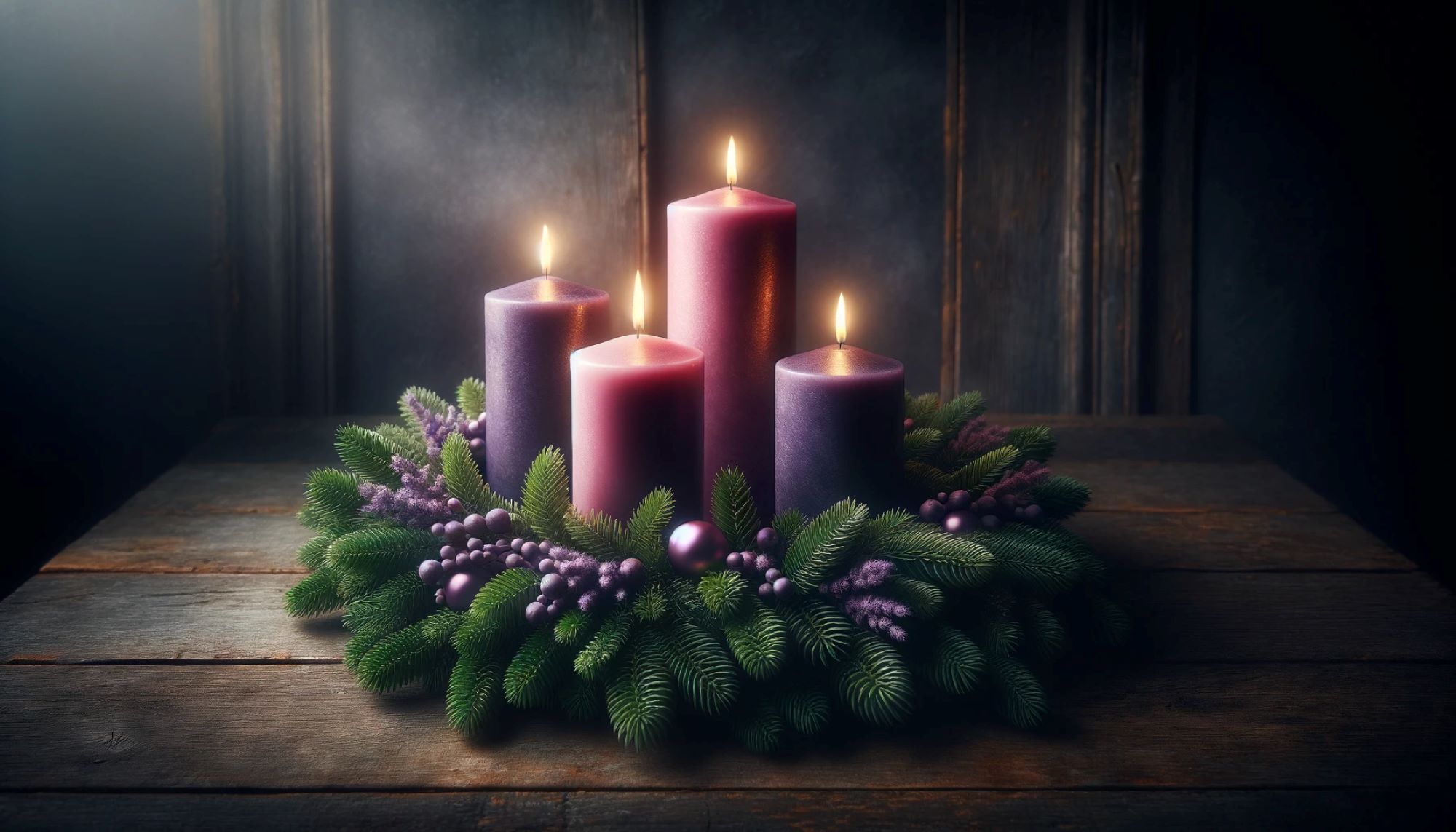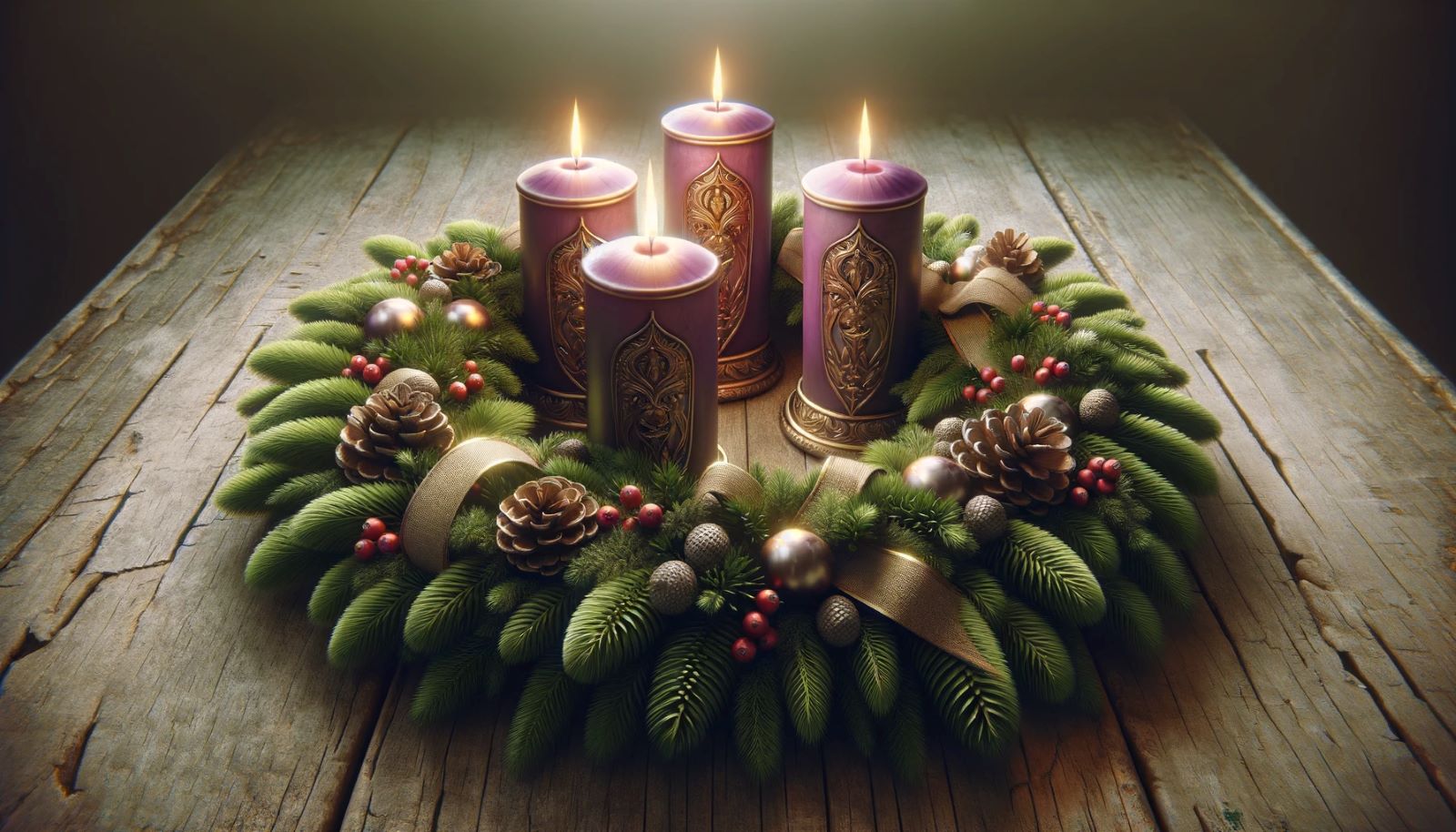Home>Special Themes>Why Pink And Purple Candles At Advent


Special Themes
Why Pink And Purple Candles At Advent
Published: February 14, 2024
Peter Smith, Editorial Director at Christian.net, combines deep insights into faith, politics, and culture to lead content creation that resonates widely. Awarded for his contributions to religious discourse, he previously headed a major organization for religious communicators, enhancing dialogue on faith's societal impacts.
Discover the significance of pink and purple candles at Advent and explore special themes associated with these colors. Uncover the spiritual and symbolic meanings behind these unique candle choices.
(Many of the links in this article redirect to a specific reviewed product. Your purchase of these products through affiliate links helps to generate commission for Christian.net, at no extra cost. Learn more)
Table of Contents
Introduction
Advent, a time of anticipation and preparation, is a cherished tradition in many Christian communities. As the holiday season approaches, the lighting of Advent candles becomes a focal point of spiritual reflection and anticipation. While the traditional colors of Advent candles are purple and blue, the inclusion of pink candles adds a unique and meaningful dimension to the observance.
The use of pink and purple candles in Advent holds deep symbolic significance, rooted in centuries-old traditions and spiritual meanings. Understanding the origins and meanings behind these colors enriches the experience of Advent, providing a deeper connection to the spiritual journey of the season.
In this article, we will delve into the symbolism, history, and significance of pink and purple candles in Advent. From the historical roots of these colors to their representation in the Christian tradition, we will explore the profound meanings that these candles hold within the context of the Advent season. Join us on this enlightening journey as we uncover the rich symbolism and spiritual depth behind the use of pink and purple candles in Advent observances.
Read more: Why Is The Advent Candle Pink
The Symbolism of Pink and Purple
The colors of pink and purple hold profound symbolism in the context of Advent, each carrying its own unique significance that enriches the observance of the season. Purple, a color traditionally associated with royalty and penitence, is a prominent hue in the Advent tradition. It symbolizes the solemn and contemplative nature of the season, prompting introspection and spiritual preparation for the celebration of Christ's birth.
In contrast, the introduction of the pink candle introduces a shift in tone within the Advent observance. Pink, often interpreted as a color of joy and celebration, serves as a powerful symbol of hope and anticipation. Its placement in the Advent wreath signifies a moment of respite and joyful anticipation amidst the introspective and penitential atmosphere represented by the purple candles.
The symbolism of pink and purple in Advent extends beyond their individual meanings, intertwining to create a narrative of spiritual progression throughout the season. As the weeks progress, the lighting of the pink candle heralds a shift in focus from solemn reflection to joyful anticipation, marking a pivotal moment in the Advent journey. This transition from penitence to joyful expectation mirrors the overarching theme of Advent as a time of preparation for the coming of Christ.
The combination of purple and pink candles in the Advent wreath thus encapsulates the multifaceted nature of the season, encompassing themes of penitence, hope, joy, and anticipation. Together, these colors weave a rich tapestry of symbolism, guiding individuals through a spiritual journey that reflects the essence of Advent.
In essence, the symbolism of pink and purple candles in Advent serves as a visual and symbolic representation of the multifaceted nature of the season, encapsulating themes of introspection, hope, and joyful anticipation. These colors, steeped in rich symbolism, invite individuals to engage with the profound spiritual significance of Advent, fostering a deeper connection to the essence of the season.
The History of Pink and Purple Candles at Advent
The historical roots of pink and purple candles in Advent can be traced back to the early traditions of the Christian church. The use of purple as a symbolic color in religious observances dates back to ancient times, where it was associated with royalty and penitence. In the context of Advent, purple candles have long been utilized to signify the solemn and contemplative nature of the season, prompting individuals to engage in introspection and spiritual preparation for the celebration of Christ's birth.
The introduction of pink candles into the Advent observance is a relatively more recent development, with its origins tied to specific liturgical traditions. The use of a pink candle in the Advent wreath is rooted in the Western Christian tradition, where it holds a distinct place in the progression of the Advent season. This tradition can be traced back to the 20th century, with the pink candle serving as a visual and symbolic representation of the theme of joy and anticipation within the broader context of Advent.
The historical significance of the pink and purple candles in Advent is closely linked to the liturgical calendar and the structure of the Advent season. As the weeks of Advent progress, the lighting of the pink candle typically occurs on the third Sunday, known as Gaudete Sunday. The term "Gaudete" is derived from the Latin word for "rejoice," emphasizing the theme of joyful anticipation as the celebration of Christ's birth draws nearer. The use of the pink candle on Gaudete Sunday serves as a poignant reminder of the imminent joy and hope embodied in the Advent season.
The incorporation of pink and purple candles into the Advent observance reflects the evolving nature of religious traditions and the adaptation of symbolic elements to convey deeper spiritual meanings. While the use of purple has remained a steadfast symbol of penitence and preparation, the addition of the pink candle has brought a nuanced dimension of joy and anticipation to the Advent experience.
In essence, the history of pink and purple candles at Advent is a testament to the rich tapestry of traditions and symbolism woven into the fabric of religious observances. These colors, steeped in historical significance, continue to enrich the Advent season, inviting individuals to engage with the profound spiritual journey that unfolds through the lighting of each candle in the Advent wreath.
The Meaning of Pink and Purple Candles in Advent Wreaths
The placement of pink and purple candles in the Advent wreath holds profound significance, encapsulating the essence of the Advent season through their symbolic representation. The Advent wreath, a cherished tradition in many Christian households and congregations, serves as a visual and spiritual focal point during the weeks leading up to Christmas. Each candle within the wreath carries its own unique symbolism, contributing to the rich tapestry of meaning woven into the observance of Advent.
Purple candles, traditionally used in Advent wreaths, symbolize the themes of penitence, preparation, and royalty. As the first and second candles are lit in the weeks leading up to Christmas, the solemn and contemplative nature of the season is emphasized, prompting individuals to engage in introspection and spiritual readiness for the celebration of Christ's birth. The deep purple hue serves as a visual reminder of the historical significance of the color in religious observances, evoking a sense of reverence and anticipation as the Advent journey unfolds.
In contrast, the introduction of the pink candle into the Advent wreath marks a pivotal moment in the progression of the season. Positioned as the third candle, often lit on Gaudete Sunday, the pink candle represents a shift in focus from penitence to joyful anticipation. Its rosy hue symbolizes the theme of joy and hope, serving as a beacon of light amidst the introspective atmosphere cultivated by the preceding purple candles. The lighting of the pink candle on Gaudete Sunday, derived from the Latin word for "rejoice," serves as a poignant reminder of the imminent joy and hope embodied in the Advent season.
The juxtaposition of pink and purple candles within the Advent wreath thus mirrors the multifaceted nature of the season, encompassing themes of introspection, hope, and joyful anticipation. As each candle is progressively lit in the weeks leading up to Christmas, the Advent wreath becomes a visual representation of the spiritual journey towards the celebration of Christ's birth. The interplay of purple and pink candles within the wreath invites individuals to engage with the profound symbolism of the season, fostering a deeper connection to the spiritual essence of Advent.
In essence, the placement of pink and purple candles in the Advent wreath serves as a visual and symbolic representation of the multifaceted nature of the Advent season, encapsulating themes of introspection, hope, and joyful anticipation. These candles, steeped in rich symbolism, guide individuals through a spiritual journey that reflects the essence of Advent, enriching the observance of the season with profound meaning and significance.
The Significance of Pink and Purple Candles in Christian Tradition
The significance of pink and purple candles in Christian tradition extends beyond their visual presence in Advent observances, delving into the profound spiritual meanings they embody within the context of the faith. These colors, deeply rooted in historical and symbolic significance, hold a revered place in the tapestry of Christian traditions, enriching the spiritual journey of the Advent season.
Purple, a color traditionally associated with royalty and penitence, has been a prominent hue in Christian liturgical practices for centuries. Its use in Advent candles symbolizes the solemn and contemplative nature of the season, prompting individuals to engage in introspection and spiritual preparation for the celebration of Christ's birth. The deep purple hue serves as a visual reminder of the historical significance of the color in religious observances, evoking a sense of reverence and anticipation as the Advent journey unfolds.
In contrast, the introduction of the pink candle into the Advent observance represents a shift in tone within the Christian tradition. Pink, often interpreted as a color of joy and celebration, serves as a powerful symbol of hope and anticipation. Its placement in the Advent wreath signifies a moment of respite and joyful anticipation amidst the introspective and penitential atmosphere represented by the purple candles. The lighting of the pink candle on Gaudete Sunday, derived from the Latin word for "rejoice," serves as a poignant reminder of the imminent joy and hope embodied in the Advent season.
The significance of pink and purple candles in Christian tradition is deeply intertwined with the spiritual journey of Advent, encapsulating themes of penitence, hope, and joyful anticipation. As the weeks progress, the lighting of the pink candle heralds a shift in focus from solemn reflection to joyful anticipation, marking a pivotal moment in the Advent journey. This transition from penitence to joyful expectation mirrors the overarching theme of Advent as a time of preparation for the coming of Christ.
In essence, the significance of pink and purple candles in Christian tradition lies in their ability to encapsulate the multifaceted nature of the Advent season, encompassing themes of introspection, hope, and joyful anticipation. These colors, steeped in rich symbolism, invite individuals to engage with the profound spiritual significance of Advent, fostering a deeper connection to the essence of the season within the Christian faith.
Conclusion
In conclusion, the symbolism, history, and significance of pink and purple candles in Advent encapsulate the essence of the season, enriching the spiritual journey of anticipation and preparation for the celebration of Christ's birth. The interplay of purple and pink candles within the Advent observance mirrors the multifaceted nature of the season, encompassing themes of introspection, hope, and joyful anticipation. The historical roots of these colors, dating back to ancient traditions and evolving within the Christian liturgical calendar, underscore their enduring significance in religious observances.
The symbolism of purple, representing penitence and royalty, prompts individuals to engage in solemn reflection and spiritual readiness as they embark on the Advent journey. The introduction of the pink candle, symbolizing joy and hope, serves as a poignant reminder of the imminent celebration of Christ's birth, infusing the season with a sense of joyful anticipation. The placement of pink and purple candles within the Advent wreath creates a visual and symbolic representation of the spiritual progression towards Christmas, guiding individuals through a profound and meaningful journey.
Furthermore, the significance of pink and purple candles in Christian tradition extends beyond their visual presence, delving into the profound spiritual meanings they embody within the context of the faith. These colors, deeply rooted in historical and symbolic significance, enrich the spiritual journey of the Advent season, inviting individuals to engage with the profound symbolism and fostering a deeper connection to the essence of the season within the Christian faith.
As individuals partake in the lighting of each candle in the Advent wreath, they are invited to immerse themselves in the rich symbolism and spiritual depth that pink and purple candles bring to the observance of Advent. The transition from penitence to joyful anticipation, marked by the lighting of the pink candle on Gaudete Sunday, serves as a poignant reminder of the overarching theme of Advent as a time of preparation for the coming of Christ, infusing the season with profound meaning and significance.
In essence, the inclusion of pink and purple candles in Advent serves as a testament to the enduring traditions and rich symbolism woven into the fabric of religious observances. These colors, steeped in historical and spiritual significance, continue to enrich the Advent season, guiding individuals through a profound spiritual journey that reflects the essence of the season.














